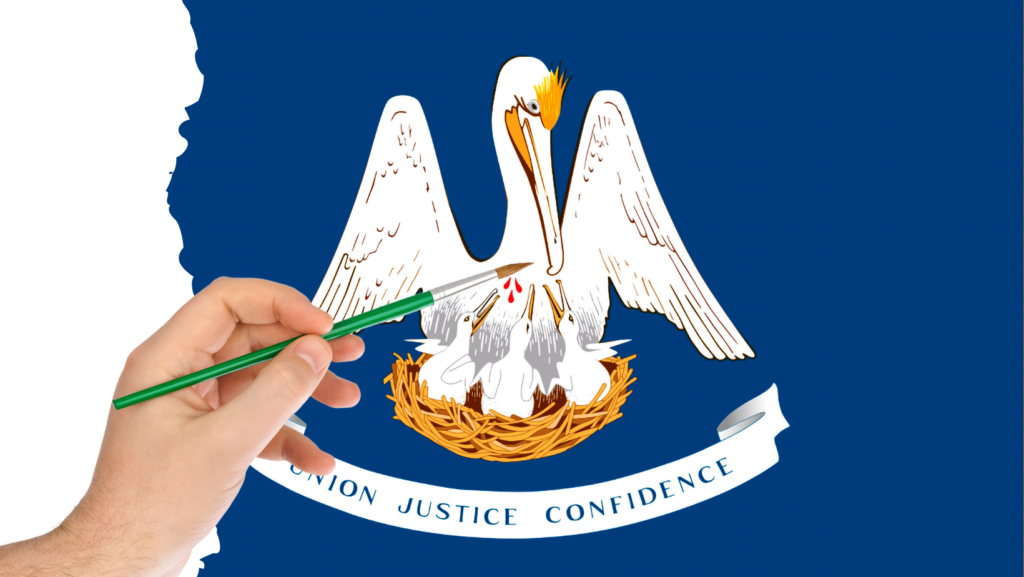There’s been quite the fuss over proposed changes to state flags, enough so that it’s worth exploring why they’re being made — and whether it’s time for a similar update in Louisiana.
We’re probably familiar with the flag overhauls from our regional neighbors who’ve sought to make a clean break from their Jim Crow pasts. Most notably, Mississippi swapped its Confederate battle flag in 2021 in favor of a white magnolia blossom. Georgia made a similar switch 20 years ago.
But this is far from just an Old South thing. Various states have decided to update their flags for various reasons.
Utah has replaced its flag, which had more of a federal feel, with one that has a beehive symbol instead of an accurate hive illustration (a nod to its Mormon roots) and adds a mountain range silhouette. It also removed the words “Industry” and “Utah” from the old version.
Seems innocuous enough, right? Well, no other bill in this year’s session of the Utah Legislature invoked more cries of “woke” and “marxist” than the new flag proposal, according to the Deseret News (keep in mind lawmakers also handled a bill dealing with gender-affirming health care this year).
Many expect a reversion to Utah’s original flag.
“I was hoping this would be a thing that brings people together,” Gov. Spencer Cox said, the Wall Street Journal reported. “I should have known better.
The State Emblems Redesign Commission in Minnesota settled on a final design for its new state flag last week, the Minnesota Reformer reported. The existing flag has been bashed for a while over its busy design and offensive portrayals of Indigenous people. In its center emblem, many see the image of a white farmer displacing a Native American.
The proposed flag references Minnesota’s nickname with a white North Star in its dark blue field. The white, green and light blue stripes represent the state’s snow, natural environment and water.
Jocular suggestions included a flag with Minnesota’s unofficial state bird — the mosquito — and one that paid tribute to the state’s culinary staple, a tater tot hotdish.
Voters in Maine will have the chance next year to decide whether their state flag will stay unchanged or revert to a version created in 1901, according to the Bangor Daily News. The current one pulls together a pine tree, moose, farmer and seaman, while the older version up for consideration has a simplistic green pine tree at its center and a blue star in the canton, all on a tan field.
The Illinois General Assembly approved the creation of a flag commission this year to consider a new design. State Sen. Doris Turner, D-Springfield, wants something different from the state seal on the current version. She feels the seal represents government, and the flag should represent the people of Illinois.
There’s no current push in Louisiana to alter our flag, but it has gone through some subtle changes. In 2006, then-Rep. Damon Baldone brought forward Vandebilt Catholic School eighth-grader Joseph Louviere’s research. He found that the flag existing at the time differed from historic descriptions of a pelican wounding herself to feed her three hatchlings with drops of her blood. Baldone authored a bill that required the state flag to incorporate Louviere’s findings.
Louisiana didn’t make the changes to its flag until 2010. The mother bird was kept white but given features to more closely resemble a brown pelican, the official state bird. Also, an apparent disdain for conjunctions surfaced, resulting in the word “and” being taken out of the state motto: Union, Justice, Confidence. Plus the flag’s blue field was slightly lightened.
The state’s first official flag was approved in 1861 and was dramatically different from the pelican version adopted in 1912. The pre-Civil War flag featured a yellow star on a red canton with 13 red, white and blue stripes. Busy much?
There’s something to be said for state flag updates that more accurately reflect a state’s culture or to remove anachronistic, offensive imagery. Yet in Louisiana’s case, it feels like it would open the door to more harm than good to suggest moving on from the current pelican banner.
Anyway, how can you not love a prehistoric-looking bird that walks with an attitude, flies with physics-defying grace and comedically plops itself into the water for a bite to eat?
Besides, if we can’t even agree on one way to pronounce “pecan,” how can we ever hope to find common ground on a new flag?
Greg LaRose is editor of the Louisiana Illuminator and has covered news in Louisiana for more than 30 years.





